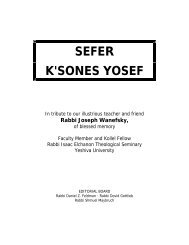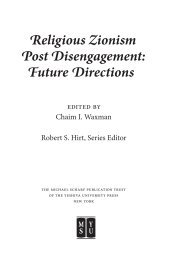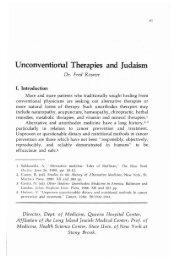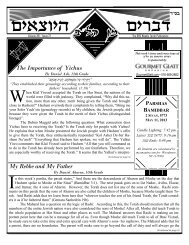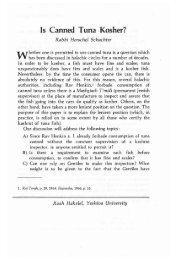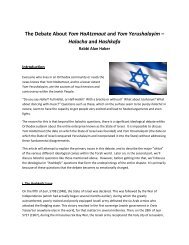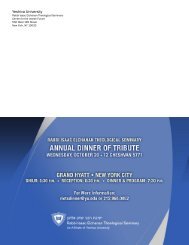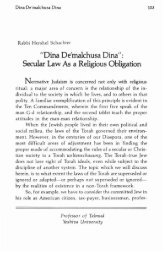Fourth, R. Yehudai Gaon (8 th century), Halachot Gedolot, Hilchot Megillah, writes that womenand children are not required <strong>to</strong> read the Megillah, but they are required <strong>to</strong> listen <strong>to</strong> the Megillah.Tosafot, Megillah 4a, s.v. nashim, note that according <strong>to</strong> R. Yehudai Gaon, a woman cannot readon behalf of a man because a man's obligation is <strong>to</strong> read the Megillah and a woman's obligation is<strong>to</strong> listen <strong>to</strong> the Megillah. R. Chanoch H. Eiges (1863-1941), Marcheshet 1:22, suggests that theapproach of Halachot Gedolot is based on R. Nachman's opinion. The obligation <strong>to</strong> read theMegillah is only a function of the obligation <strong>to</strong> recite Hallel. Since women are exempt fromHallel, they only have an obligation <strong>to</strong> listen <strong>to</strong> the Megillah. Therefore, R. Eiges rules that at thenighttime reading, both men and women only have an obligation <strong>to</strong> listen <strong>to</strong> the Megillah andtherefore, a woman may read on behalf of a man.R. Aryeh Z. Pomeranchik (1908-1942), Emek Beracha, Keriat HaMegillah no. 3, deduces theexact opposite conclusion. He assumes that women are obligated <strong>to</strong> recite Hallel and thereforesuggests that both men and women have an equal obligation <strong>to</strong> read the megillah during the day.Halachot Gedolot's idea only applies <strong>to</strong> the nighttime reading.Fifth, R. Yekutiel Halberstam (1905-1994), Divrei Yatziv, Orach Chaim 2:296, discusses twodifferent cus<strong>to</strong>ms regarding when one should perform a circumcision that occurs on Purim.According <strong>to</strong> R. Yosef Karo (1488-1575), Bedek HaBayit, Yoreh De'ah no. 262, the circumcisionshould be performed after the reading of the Megillah. According <strong>to</strong> Rama (1520-1572), OrachChaim 693:4, the circumcision should take place before the reading of the Megillah.R. Halberstam suggests that these two cus<strong>to</strong>ms may reflect the two approaches regardingrecitation of Hallel on Purim. If the reading of the Megillah serves as the recitation of Hallel, itwould not be appropriate <strong>to</strong> perform a circumcision between the Amidah and the reading of theMegillah because according <strong>to</strong> the Tosefta, Menachot 6:5, the Amidah and Hallel are inherentlylinked. If there is no requirement <strong>to</strong> recite Hallel, one may perform a circumcision between theAmidah and the reading of the Megillah. R. Halberstam adds that the cus<strong>to</strong>m <strong>to</strong> perform thecircumcision specifically before the reading of the Megillah may be <strong>to</strong> show that we follow theopinion of Rava that there is no requirement of Hallel on Purim.Sixth, R. Ya'akov Y. Algazi (1680-1756), Chug Ha'Aretz no. 16, discusses the law that if ShushanPurim occurs on Shabbat, those who live in a walled city read the Megillah on Friday (Mishna,Megillah 2a). R. Algazi asks: granted that one cannot read the Megillah on Shabbat, but why isn'tthere a recitation of Hallel on Shabbat, the day when Purim actually occurs? He answers that itwould cause confusion in other years. Alternatively, the reading of the Megillah on Friday servesas the Hallel for the actual day of Purim. R. Algazi's question is only applicable according <strong>to</strong> R.Nachman. According <strong>to</strong> Rava, there is no reason <strong>to</strong> entertain recitation of Hallel in such asituation.R. Yosef D. Soloveitchik (1903-1993, cited in Harerei Kedem 1:192) provides two more insightsin<strong>to</strong> how R. Nachman's position impacts the reading of the Megillah. First, Orchot Chaim,Hilchot Megillah no. 24, rules that if there is no minyan (a group of ten male adults) available,each person should read the Megillah on his own. If there is someone who is unable <strong>to</strong> read onhis own, someone may read for him and he will fulfill the mitzvah by listening. R. Avraham25YESHIVA UNIVERSITY <strong>•</strong> PURIM TO-GO <strong>•</strong> ADAR <strong>5771</strong>
Gombiner (c.1633-1683), Magen Avraham 689:10, explains that although the principle ofshomei'a k'oneh (the listener is like the responder) should allow one <strong>to</strong> listen <strong>to</strong> the reading of theMegillah from someone else, the reading of the Megillah is similar <strong>to</strong> tefillah (prayer). Regardingtefillah, each person must pray on his own unless it is within the context of a minyan or he doesnot know how <strong>to</strong> pray on his own.R. Soloveitchik notes that Magen Avraham's comparison of reading the Megillah <strong>to</strong> tefillah seems<strong>to</strong> be based on the principle that reading the Megillah fulfills the obligation <strong>to</strong> recite Hallel onPurim. Since one aspect of reading the Megillah is Hallel, when there is no minyan, it ispreferable for each individual <strong>to</strong> read on his own.Second, R. Soloveitchik notes that the Hallel aspect of the reading of the Megillah explains whycertain verses of the Megillah are read by the entire congregation. Regarding Hallel, the Gemara,Sukkah 38b, states that certain portions of Hallel should be recited responsively (i.e. one personreads a verse and the rest of the congregation responds). The responsive reading of some of theverses in the Megillah serves <strong>to</strong> fulfill that requirement.26YESHIVA UNIVERSITY <strong>•</strong> PURIM TO-GO <strong>•</strong> ADAR <strong>5771</strong>



